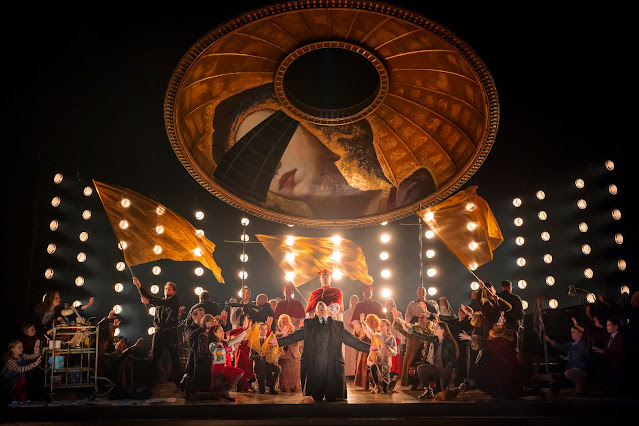,%20Jessica%20Cale%20(Giulietta)%20(c)%20Richard%20Hubert%20Smith.jpg) |
| Bellini: The Capulets & the Montagues - Brenton Spiteri, Jessica Cale, Masimba Ushe - English Touring Opera, 2025 (Photo: © Richard Hubert Smith) |
Bellini: The Capulets and the Montagues; Jessica Cale, Samantha Price, Brenton Spiteri, Timothy Nelson, Masimba Ushe, director: Eloise Lally, conductor: Alphonse Cemin, English Touring Opera; Hackney Empire
Reviewed 22 February 2025
A 1950s Mafia based account Bellini's star-crossed lovers imbued with magic thanks to engaging and stylish soloists, along with a strong musicality for the ensemble
Following the failure of his opera Zaira in Parma in 1829, and the resultant straining of Bellini's relationship with his librettist, Felice Romani, the composer found himself without a contract for a new opera. In Venice, for Carnival performances of his opera Il Pirata, he ended up taking up a contract for a new opera when it became apparent that the planned composer, Pacini, was not going to be able to deliver.
The new work had to be written at speed, something Bellini was not good at. A new Bellini opera was 'reassuringly expensive' because the composer prided himself on the time he devoted the writing. In this case, Romani quickly reworked an existing libretto, originally written for Giulietta e Romeo by Niccola Vaccai which premiered in Milan in 1825. The original source was an Italian play of 1818, based on a source related to that Shakespeare used. Not only was the libretto based on existing material, but Bellini reused material from Zaira as well as lifting two arias from his first opera, Adelson e Salvini (written for the conservatoire in Naples, but never professionally performed).
The new opera was a success, sealing Bellini's fame, and it was performed at La Scala, Milan the following season. However, during the 19th century Bellini's opera remained inextricably linked to Vaccai's. In 1832, Maria Malibran performed the role of Romeo in Bellini's opera but asked for the final scene to be replaced by the corresponding scene in Vaccai's opera. This became common practice in Italy during the 19th century, making the mezzo-soprano role of Romeo more accessible to contraltos.
,%20Jessica%20Cale%20(Giulietta)%20(c)%20Richard%20Hubert%20Smith%20(2).jpg) |
| Bellini: The Capulets & the Montagues - Samantha Price, Jessica Cale - English Touring Opera, 2025 (Photo: © Richard Hubert Smith) |
It is a relatively compact work, focused strongly on the two lovers and with a plot that, though differing somewhat from Shakespeare, requires little explanation for audiences. As such, it is a relatively popular choice with opera companies seeking a Bellini opera for performance.
Covent Garden's 1984 production of the work (last seen in 2009), designed and directed by Pier Luigi Pizzi, is the only one I have seen to stage the work in the original setting and most companies opt for an updating, transposing the violence to more modern gangsters.
English Touring Opera's Spring season is taking Shakespeare as its theme. Alongside a new studio work, What Dreams May Come using settings of the playwright's texts by diverse composers and a new opera by Michael Betteridge, The Vanishing Forest, aimed at children, the company is touring its production of Bellini's Capulets and Montagues directed by Eloise Lally [who directed the company's 2023 production of Donizetti's Lucrezia Borgia, see my review].
We caught the opening night at Hackney Empire on Saturday 22 February 2025. The conductor was Alphonse Cemin [whom we heard as pianist earlier this year accompanying baritone Julien Van Mellaerts in his music exploration of a Paris cemetery at Wigmore Hall, see my review], with Jessica Cale as Giulietta [Poppea in ETO's 2023 production of Monteverdi's L'incoronazione di Poppea, see my review], and Samantha Price as Romeo (she sang the title role in G&S Iolanthe at ENO in 2023, see my review), plus Brenton Spiteri as Tebaldo, Timothy Nelson as Capellio and Masimba Ushe as Lorenzo. The orchestra was admirably full, with 12 strings, double woodwind, single brass, timpani and harp, plus an choral ensemble of seven men.









.jpg)
,%20Jessica%20Cale%20(Giulietta)%20(c)%20Richard%20Hubert%20Smith.jpg)
,%20Jessica%20Cale%20(Giulietta)%20(c)%20Richard%20Hubert%20Smith%20(2).jpg)








.jpg)
.jpg)
.jpg)






.jpg.webp)
.png)








%20as%20Leporello%20and%20Erik%20Tofte%20(back%20to%20camera%20in%20garnet%20shirt)%20as%20Giovanni%20-%20Don%20Giovanni.jpg)


